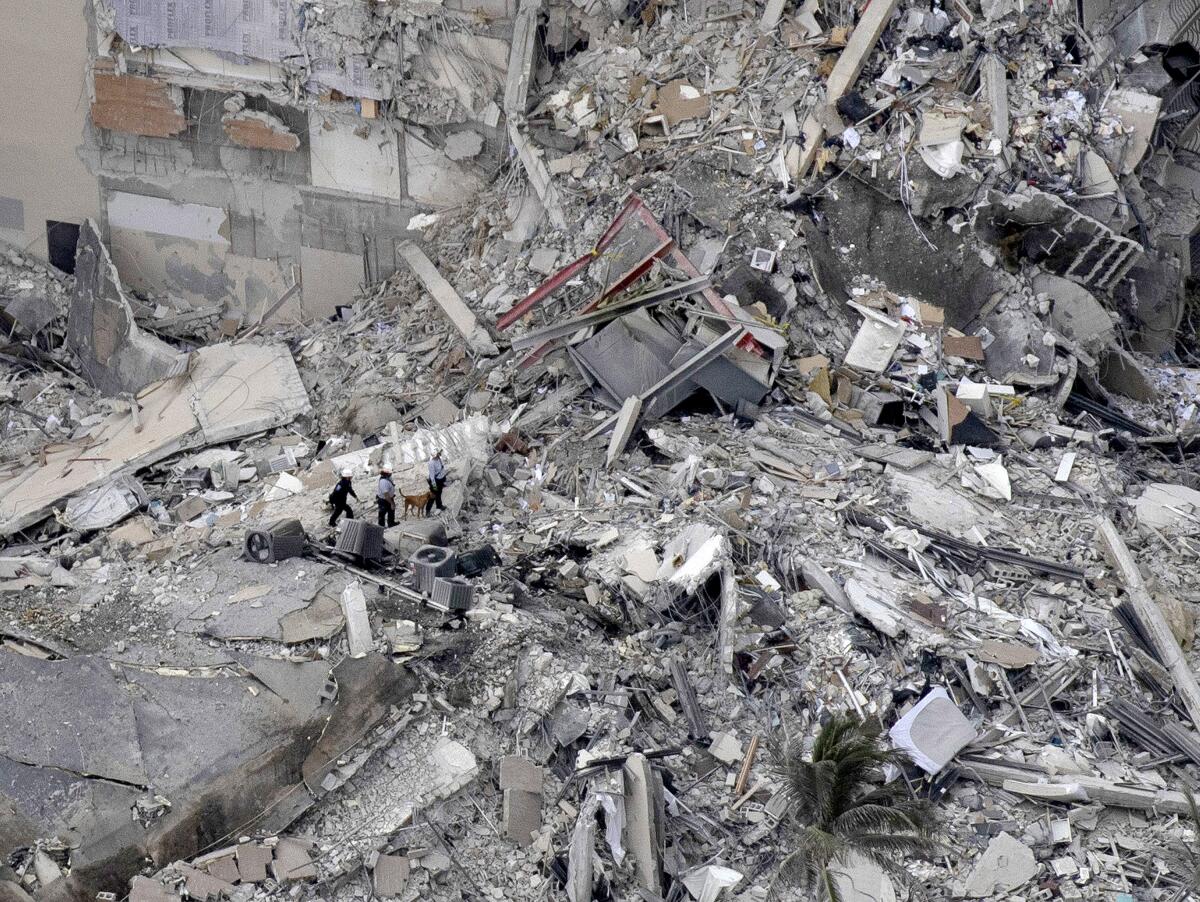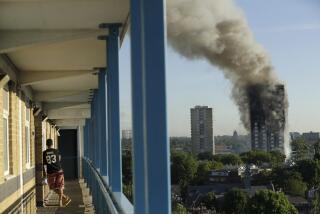Op-Ed: What comes in the wake of a terrifying building collapse

Itâs been 40 years since 114 were killed and 200 others injured when two giant skywalks collapsed in the lobby of the Hyatt Regency hotel in Kansas City, Mo. The images from that catastrophic structural failure â chunks of the walkways flattened to gray rubble, firemen clawing through busted concrete in search of the living or dead, the anguish of families desperate for news â seem to have been replayed in Surfside, Fla., over the past five days.
In the weeks, months and a year or more ahead, even grimmer moments will follow. And answers could take years, if they come at all.
Why did the high-rise Champlain Towers South condo building suddenly collapse in the pre-dawn hours Thursday? Whom should we blame? Will this community ever find closure over such an enveloping tragedy? As of Monday morning, 10 bodies had been recovered in the Surfside disaster; about 150 other people are missing.
The experts reviewing the Florida disaster are considering several scenarios: whether the beachfront building snapped near the underground parking garage, sending the 12 stories and 136 condos toppling down; or the foundation eroded from ocean saltwater or rising tides; a roof renovation project went wrong; or the outdoor pool splintered. One witnesses heard an eerie creaking sound. Others spied cracks around the site. Some felt the building shaking. Others spotted a sinkhole near the pool.
An advance warning had been sounded. A consultant in 2018 found evidence âof major structural damageâ below the pool deck and âabundantâ cracking of concrete beams and walls in the garage area. Afterward, however, the community was assured by a town inspector that the Champlain Towers complex remained âin very good shape.â
A similar alert arose at the Hyatt Regency when the lobby ceiling collapsed during the hotel construction. The owners learned that many of the atrium connections were weakening. They repaired the roof but missed the lobby skywalks, which later pulled apart, largely because of an engineering design error.
Also in the Hyatt case, seven months passed before federal investigators pinpointed the structural design error. In Florida, federal investigators from Washington are offering their expertise, but it likely will take longer to determine if outside factors like water or weather were involved. A number of local and state agencies will be involved in the inquiry, though itâs not clear which agency would lead the effort. Separate experts are also being hired by the building owners and the families considering lawsuits. All of this could compound or delay a definitive answer into why the seaside tower crumbled.
Already, a lawsuit seeking more than $5 million has been filed by condo residents. Yet typically in mass disaster cases, the complicated litigation â usually a class action suit â ends with out-of-court settlements and no public trial. There is only so much insurance money to go around, and the courts in recent decades have worked to accommodate everyone equitably.
What can be all the more agonizing is that the lawsuits plod along with legal depositions, evidentiary findings and pre-trial hearings for years. And then the cases are abruptly resolved with a settlement just before a trial starts. The process can leave survivors and their families spinning. The lack of a trial often means families donât get the closure they might want.
Seldom is any individual held personally responsible; only the corporate entities or the construction companies acknowledge fault. In the Hyatt case, two structural engineers were punished in a state regulatory matter. They lost their licenses to practice engineering in Missouri. All of the lawsuits were settled in state and federal courts, and an estimated $140 million was paid out to victims.
Class action remedies have become the norm in mass disaster cases. No trial was held in the 2017 shooting rampage in Las Vegas that left 60 dead and hundreds wounded. In that case, an $800-million out-of-court arrangement resolved the litigation. No public reckoning has ever explained why a casino high-roller stocked his hotel room with assault rifles and opened fire on an outdoor concert below. Florida might very well end up with no full answers either.
Since 1981, there have been some significant advancements. Engineering and architectural standards have been tightened up. Today, PTSD therapy is offered to firefighters, police and paramedics.
But this much is certain: Even when the cause of the collapse is known in Florida, even after the litigation is done and the experts snap their briefcases shut, many affected in that community will never be made whole. In Kansas City, scores of survivors, families and first responders still tumble into tears at the memory of the summer of 1981.
For now, as Mayor Charles Burkett said on Sunday, with the growing likelihood that no one else will be found alive, âWe just need a few more miracles each day.â
Richard A. Serrano, a former Times reporter, is the author of the forthcoming book âBuried Truths and the Hyatt Skywalks: The Legacy of Americaâs Epic Structural Failure.â
More to Read
A cure for the common opinion
Get thought-provoking perspectives with our weekly newsletter.
You may occasionally receive promotional content from the Los Angeles Times.










